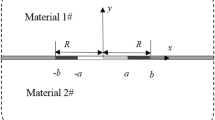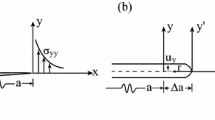Abstract
Thermal stresses, one of the main causes of interfacial failure between dissimilar materials, arise from different coefficients of linear thermal expansion. Two efficient numerical procedures in conjunction with the finite element method (FEM) for the stress intensity factor (SIF) analysis of interface cracks under thermal stresses are presented. The virtual crack extension method and the crack closure integral method are modified using the superposition method. The SIF analyses of some interface crack problems under mechanical and thermal loads are demonstrated. Very accurate mode separated SIFs are obtained using these methods.
Similar content being viewed by others
References
Atkinson, C. (1982). The interface crack with a contact zone. International Journal of Fracture 18, 161–177.
Brown, E.J. and Erdogan, F. (1968). Thermal stresses in bonded materials containing cuts on the interface. International Journal of Engineering Science 6, 517–529.
Comninou, M. (1977a). The interface crack. Trans. ASME Series E. Journal of Applied Mechanics 44, 631–636.
Comninou, M. (1977b). Interface crack with friction in the contact zone. Trans. ASME Series E. Journal of Applied Mechanics 44, 780–781.
Comininou, M. and Schmueser, D. (1979). The interface crack in a combined tension-compression and shear field. Trans. ASME Series E. Journal of Applied Mechanics 46, 345–348.
England, A.H. (1965). A crack between dissimilar media. Journal of Applied Mechanics 32, 400–402.
Erdogan, F. (1963). Stress distribution in nonhomogeneous elastic plane with cracks. Journal of Applied Mechanics 30, 232–236.
Erdogan, F. (1965). Stress distribution in bonded dissimilar materials with cracks. Journal of Applied Mechanics 32, 403–410.
Hutchinson, J.W., Mear, M. and Rice, J.R. (1987). Crack paralleling an interface between dissimilar materials. Journal of Applied Mechanics 54, 828–832.
Hutchinson, J.W. and Suo, Z. (1992). Mixed mode cracking in layered materials. Advances in Applied Mechanics 29, 63–191.
Hucker, S.A. and Farris, T.N. (1993). Modified crack closure method using boundary elements. Engineering Fracture Mechanics 46, 763–772.
Irwin, G.R. (1957). Analysis of stresses and strains near the end of a crack traversing a plate. Journal of Applied Mechanics 24, 361-366.
Mak, A.F., Keer, L M., Chen, S.H. and Lewis, J.L. (1980). A no-slip interface crack. Trans. ASME Series E. Journal of Applied Mechanics 47, 347–350.
Malyshev, B. and Salganik, R. (1965). The strength of adhesive joints using the theory of cracks. International Journal of Fracture and Mechanics 1, 114–119.
Matos, P.P.L., McMeeking, R.M., Charalambides, P.G. and Drory, M.D. (1989). A method for calculating stress intensities in bimaterial fracture. International Journal of Fracture 40, 235–254.
Miyazaki, N., Ikeda, T., Soda, T. and Munakata, T. (1993a). Stress intensity factor analysis of interface crack using boundary element method (Application of virtual crack extension method). JSME International Journal (Series A) 36–1, 36–42.
Miyazaki, N., Ikeda, T., Soda, T. and Munakata, T. (1993b). Stress intensity factor analysis of interface crack using boundary element method (Application of contour-integral method). Engineering Fracture Mechanics 45–5, 599–610.
Parks, D.M. (1974). A stiffness derivative finite element technique for determination of crack tip stress intensity factors. International Journal of Fracture 10–4, 487–502.
Parks, D.M. (1978). Virtual crack extension: a general finite element technique for J-integral evaluation. Proceedings 1st International Conference on Numerical Methods in Fracture Mechanics, 464–478.
Raju, I.S., Crews, J.H., Jr. and Aminpour, M.A. (1988). Convergence of strain energy release rate components for edge-delaminated composite laminates. Engineering Fracture Mechanics 30, 383–396.
Rice, J.R. (1968). A path independent integral and the approximate analysis of strain concentration by notches and cracks. Journal of Applied Mechanics 35, 379–386.
Rice, J.R. (1988). Elastic fracture mechanics concepts for interfacial cracks. Journal of Applied Mechanics 55, 98–103.
Rice, J.R. and Sih, G.C. (1965). Plane problems of cracks in dissimilar media. Journal of Applied Mechanics 32, 418–423.
Rybicki, E.F. and Kanninen, M.F. (1977). A finite element calculation of stress intensity factors by a modified crack closure integral. Engineering Fracture Mechanics 9, 931–938.
Salganik, R. L. (1963). The brittle fracture of cemented bodies. Prikl. Mat. Mekh. 27, 1468–1478.
Shih, C.F. and Asaro, R.J. (1990). Elastic-plastic and asymptotic fields of interface cracks. International Journal of Fracture 42, 101–116.
Sun, C.T. and Jih, C.J. (1987). On strain energy release rates for interfacial cracks in bi-material media. Engineering Fracture Mechanics 28, 13–20.
Sun, C.T. and Qian, W. (1997). The use of finite extension strain energy release rates in fracture of interfacial cracks. International Journal of Solids and Structure 34, 2595–2609.
Wang, J.S. and Suo, Z. (1990). Experimental determination of interfacial toughness curves using Brazil-nutsandwiches. Acta Metallurgica Materials 38–7, 1279–1290.
Williams, M.L. (1959). The stresses around a fault or crack in dissimilar media. Bulleting Seismology Society America 49, 199–204.
Yau, J.F. and Wang, S.S. (1984). An analysis of interface cracks between dissimilar isotropic materials using conservation integrals in elasticity. Engineering Fracture Mechanics 20–3, 423–432.
Yuuki, R. and Cho, S.B. (1989). Efficient boundary element analysis of stress intensity factors for interface cracks in dissimilar materials. Engineering Fracture Mechanics 34, 179–188.
Zywicz, E. and Parks, D.M. (1989). Elastic yield zone around an interfacial crack tip. Trans. ASME Series E. Journal of Applied Mechanics 56, 577–584.
Author information
Authors and Affiliations
Rights and permissions
About this article
Cite this article
Ikeda, T., Sun, C. Stress intensity factor analysis for an interface crack between dissimilar isotropic materials under thermal stress. International Journal of Fracture 111, 229–249 (2001). https://doi.org/10.1023/A:1012208409795
Issue Date:
DOI: https://doi.org/10.1023/A:1012208409795




